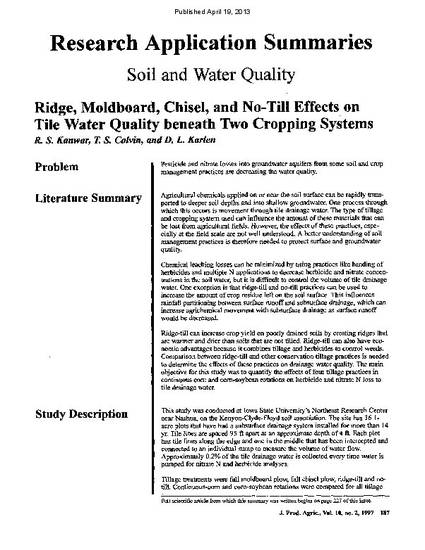
Soil conservation tillage systems, including ridge-tillage, often reduce surface water contamination by pesticides because soil erosion and surface runoff are reduced. However, the effects on losses through subsurface drainage tile are somewhat uncertain. Our field study quantified the effects of four tillage practices in continuous corn (Zea mays L.) and corn-soybean [Glycine max (L.) Merr] rotations on herbicide and nitrate N losses in tile drainage water. Fertilizer and pesticide application methods were uniform for ridge, moldboard, chisel, and no-till systems. Pesticide and nitrate N leaching losses were significantly affected by crop rotation. Tillage practice had little influence on nitrate N and pesticide losses to the subsurface drainage water within a corn-soybean rotation. However, ridge-till and no-till resulted in larger losses of atrazine than the moldboard plow and chisel based systems under continuous corn. Tillage system did not affect the timings of peak tile flow occurrences, although peak tile flow volume was affected by tillage, presumably because each system bad its own macropore system related to preservation or annual destruction of biopores by tillage. Corn yields were significantly higher under corn-soybean rotation than with continuous-corn for all tillage practices. These results indicate that continuous corn production is not an environmentally sustainable practice for this area because it resulted in higher nitrate N leaching losses to groundwater, received higher N-applications, and resulted in lower corn yields than the corn-soybean rotation. The results also reinforce the need for studies on chemical placement, rate, and timing for various tillage practices to reduce tile drainage losses of agricultural chemicals.
Available at: http://works.bepress.com/douglas_karlen/31/

This article is from Journal of Production Agriculture 10 (1997): 227–234, doi:10.2134/jpa1997.0227.